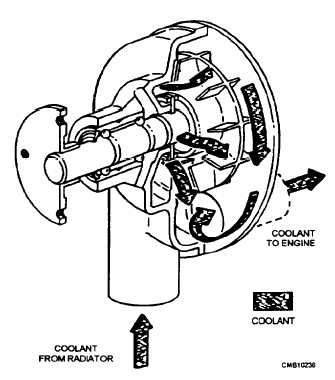WATER PUMP IMPELLER - a disc with fanlike blades that spins and produces pressure and flow.
WATER PUMP SHAFT - steel shaft that transfers turning force from the hub to impeller.
WATER PUMP SEAL - prevents coolant leakage between pump shaft and pump housing.
WATER PUMP BEARING - plain or ball bearing that allows the pump shaft to spin freely in the housing.
WATER PUMP HUB& - provides mounting place for the belt and fan.
WATER PUMP HOUSING - iron or aluminum casting that forms the main body of the pump.
The water pump normally mounts on the front of the engine. With some transverse (sideways) mounted engines, it may bolt to the side of the engine and extend towards the front.
A water pump gasket fits between the engine and the pump housing to prevent coolant leakage. RTV sealer may be used instead of a gasket.
Operation of the water pump is as follows (fig. 6-8):

Figure 6-8. - Water pump operation.
The spinning crankshaft pulley causes the fan belt to turn the water pump pulley, pump shaft, and impeller.
Coolant trapped between the impeller blades is thrown outward, producing suction in the central area of the pump housing.
Since the pump inlet is near the center, coolant is pulled out of the radiator, through the lower radiator hose.
After being thrown outward and pressurized, the coolant flows into the engine. It circulates through the block, around the cylinders, up through the cylinder heads, and back into the radiator.
Fan and Shroud
The cooling system fan pulls a large volume of air through the radiator core that cools the hot water circulating through the radiator. A fan belt or an electric motor drives the fan A fan driven by a fan belt, is known as an engine-powered fan and is bolted to the water pump hub and pulley. Sometimes a spacer fits between the fan and pulley to move the fan closer to the radiator. Besides removing heat from the coolant in the radiator, the flow of air created by the fan causes some direct cooling of the engine itself.
Fan blades are spaced at intervals around the fan hub to aid in controlling vibration and noise. They are often curled at the tip to increase their ability to move air. Except for differences in location around the hub, most blades have the same pitch and angularity.
Bent fan blades are very common and result in noise, vibration, and excess wear on the water pump shaft. You should inspect the fan blades, pulleys, pump shaft end play, and drive belt at every preventive maintenance inspection. A variable pitch (flex) fan has thin, flexible blades that alter airflow with engine speed (fig. 6-9). These fan blades are made to change pitch as the speed of the fan increases so that the fan will not create excessive noise or draw excessive engine power at highway speeds. At low speeds, the fan blades remain curved and pull air through the radiator. At higher speeds, the blades flex until they are almost straight. This reduces fan action and saves engine power.
The fluid coupling fan clutch is designed to slip at high speeds, performing the same function as a flexible fan. The clutch is filled with silicone-based oil. Fan
Continue Reading